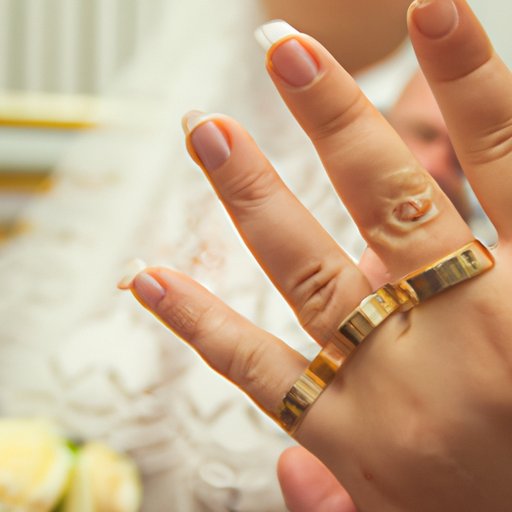Introduction
A wedding ring, also known as a marriage ring, is a metal band worn as a symbol of marriage or commitment. It is usually made of gold, silver, or platinum and is worn on the fourth finger of the left hand. But why is this so? This article will explore the various cultures and traditions around wearing a wedding ring on a specific finger in order to gain a better understanding of why this finger is chosen.
Traditional Wedding Ring Wearing: Which Finger is the Right One?
Traditionally, wedding rings are worn on the fourth finger of the left hand. This is because it is believed that this finger has a vein that connects directly to the heart. This superstition dates back to ancient times when it was thought that this finger contained a vein called the “vena amoris”, Latin for “vein of love”. This vein is thought to be connected directly to the heart, making it a symbolic gesture of love and devotion.
The significance behind the choice of the fourth finger is that it represents a union between two people. Wearing a wedding ring on this finger signifies that the couple is now one, united in love and commitment. It is also a reminder of their vows and promises to each other. The ring is a constant reminder of the love and devotion they share.
A Brief History of Why the Wedding Ring is Worn on the Fourth Finger
The tradition of wearing a wedding ring on the fourth finger can be traced back to ancient times. In Ancient Rome, it was believed that this finger held a vein that ran directly to the heart and was therefore seen as a symbol of eternal love and devotion. This belief is still prevalent today, although it is not necessarily based on scientific fact.
In modern times, the tradition has evolved somewhat. Most couples choose to wear their wedding rings on the fourth finger of the left hand as a sign of their commitment and love. This is seen as a sign of unity and is often accompanied by a ceremony to mark the occasion.
What Does it Mean to Wear Your Wedding Ring on the Fourth Finger?
Wearing your wedding ring on the fourth finger of the left hand is symbolic of your commitment and love. It is a physical representation of the bond between two people and a reminder of the promises made to each other. The ring is also a sign of unity, representing two people who are now one.
The symbolism of wearing a wedding ring on the fourth finger is also deeply rooted in culture. In many cultures, it is seen as a sign of status, wealth, and prestige. For some, wearing a ring on this finger is a sign of fidelity and faithfulness in a relationship.

An Overview of the Different Cultures and Traditions Around Wearing a Wedding Ring on a Specific Finger
The tradition of wearing a wedding ring on the fourth finger is not limited to just one culture or region. Different countries have their own customs and beliefs surrounding the practice. In Europe, for example, it is customary for the groom to place the ring on the bride’s fourth finger during the wedding ceremony. In Eastern cultures, the ring is often placed on the right hand instead of the left.
Many cultures also believe that there is spiritual significance to the wearing of a wedding ring. In certain religions, such as Hinduism and Buddhism, it is believed that the ring acts as a conduit through which positive energy is transferred between two people. In some cultures, the ring is even seen as a protection against evil spirits.
Conclusion
This article has explored the various cultures and traditions around wearing a wedding ring on a specific finger. We have discussed why the fourth finger on the left hand is traditionally chosen, as well as the symbolism and cultural implications behind the choice. We have also looked at the different customs and beliefs from around the world related to the wearing of a wedding ring.
It is clear that the wearing of a wedding ring on the fourth finger is deeply rooted in culture and tradition. Whether it is seen as a sign of unity, a symbol of love, or a conduit for positive energy, the choice of finger is an important one and should be made with careful consideration.


